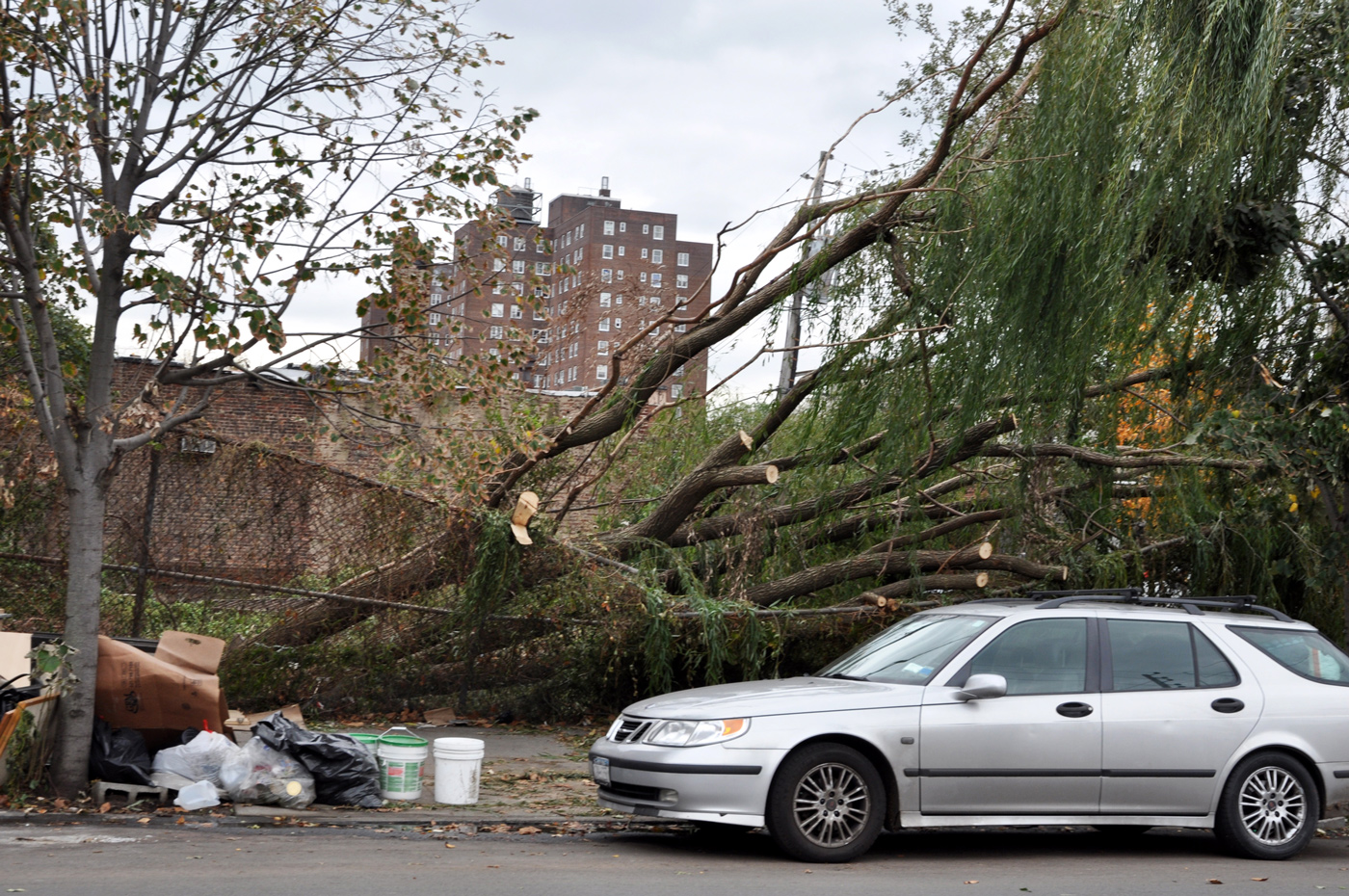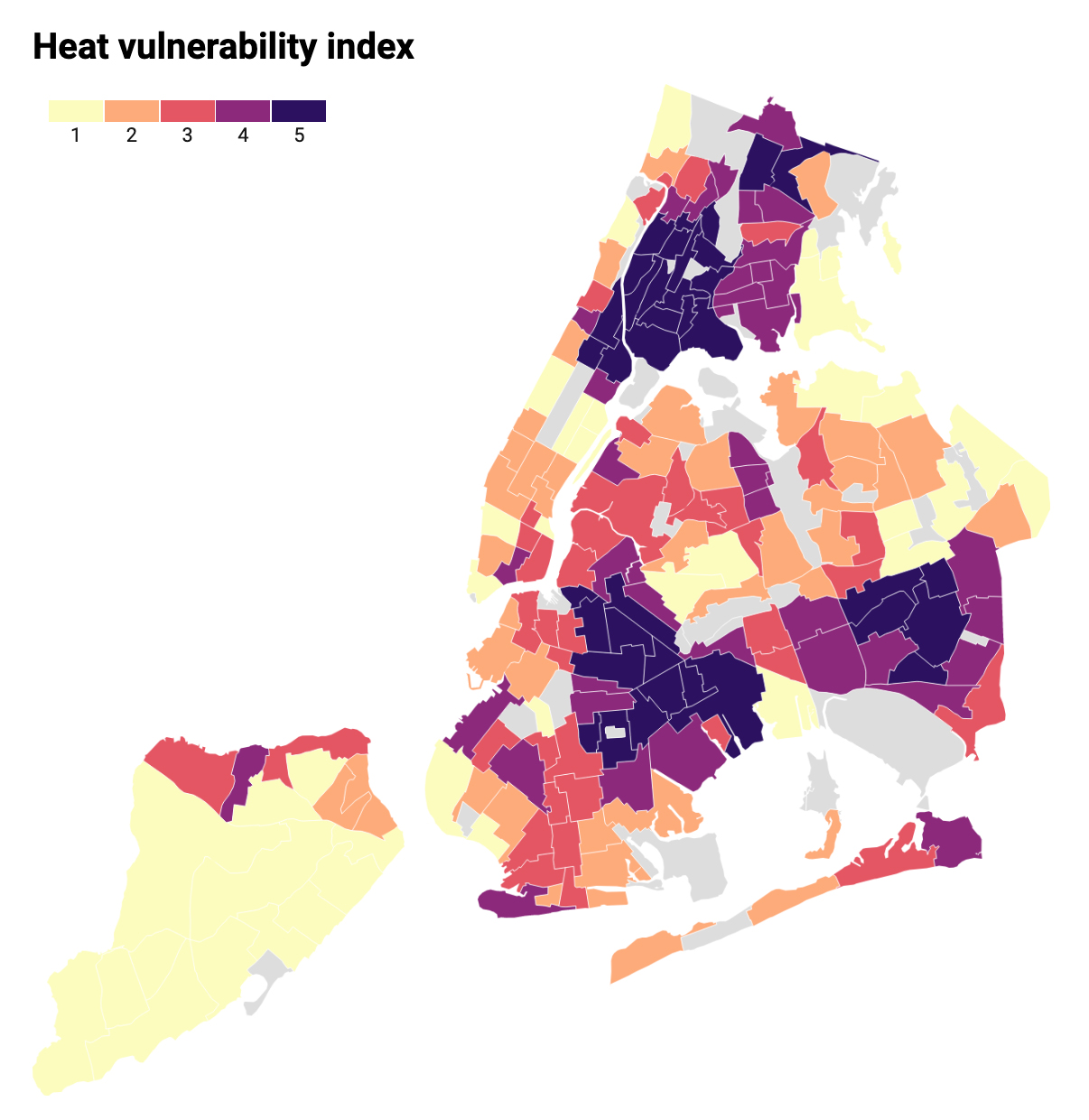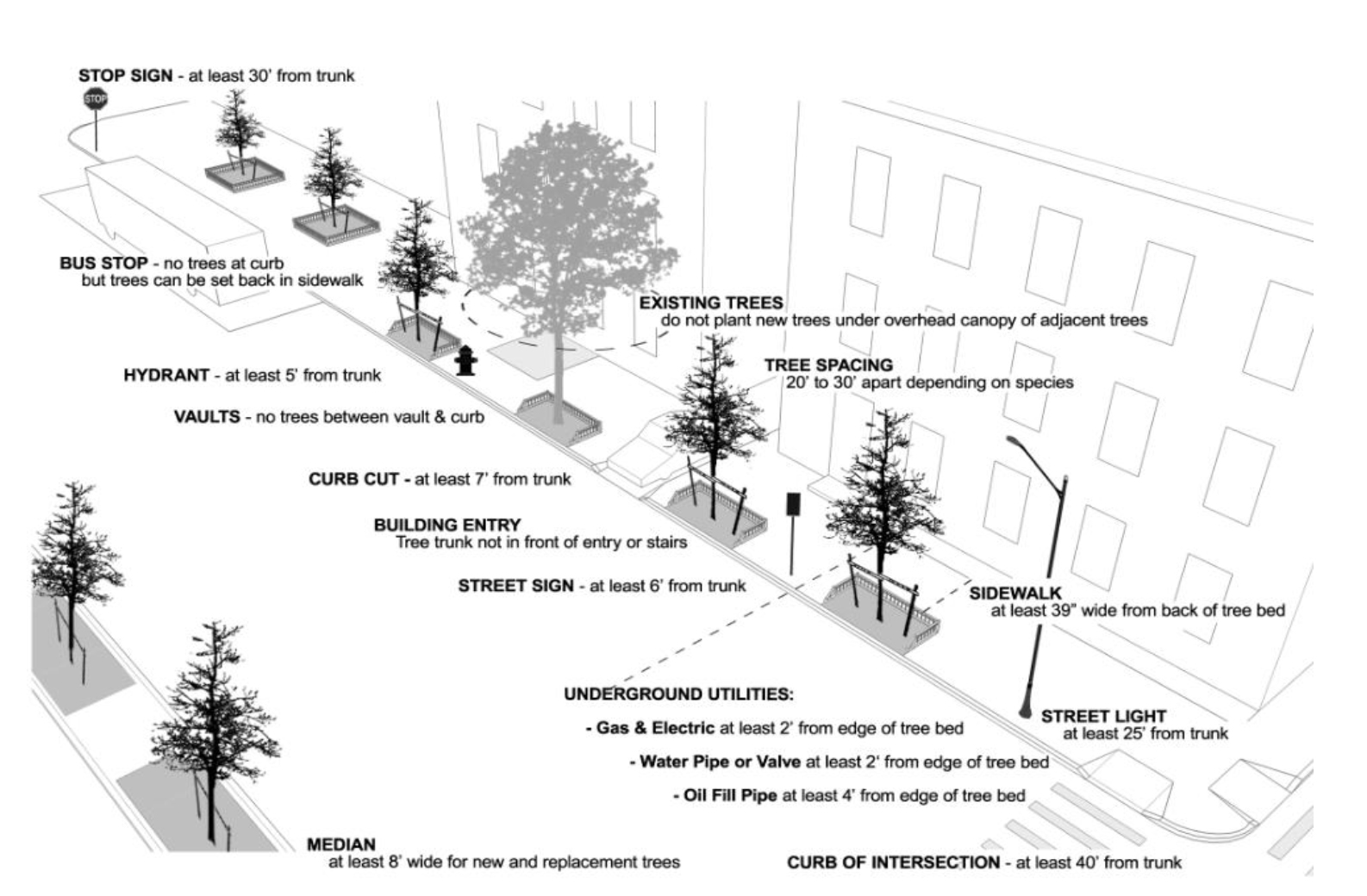
We are celebrating 15 years — and counting — of stories that are deeply researched and deeply felt, that build a historical record of what the city has been.
We are celebrating 15 years — and counting — of stories that are deeply researched and deeply felt, that build a historical record of what the city has been.
What’s better than a million new trees? Perhaps a million more? In February 2022, nearly 15 years after the launch of the ambitious MillionTreesNYC initiative, New York City’s borough presidents joined forces to propose rebooting the program and redoubling the original effort’s eponymous goal by 2030. The news followed on the heels of The Nature Conservancy’s recently-released State of the Urban Forest in NYC report which, in conjunction with aims of a coalition-driven NYC Urban Forest Agenda, provides 200-plus pages of multifaceted research in support of increasing New York’s canopy, and establishing an environmentally just approach to maintaining its long-term resilience. Seemingly a rare point of social and political consensus, urban trees, especially those lining the city’s streets, may be having a moment.
That consensus, however, comes with some qualifications. The measurement of street trees’ value has evolved since the heady optimism of the Bloomberg era. Where the original MillionTreesNYC initially emphasized environmental benefits alongside increased property values and crime prevention, street tree work has since — in step with increasing awareness of the city’s widespread and longstanding inequities — more explicitly focused on issues ranging from urban heat islands to public health and a more equitable distribution of canopy across the city’s neighborhoods. Navé Strauss, the Director of Street Tree Planting at the New York City Department of Parks and Recreation (NYC Parks), has been at the center of these shifts for more than a decade; first joining the division as a forester during the heyday of MillionTreesNYC, he has a deep understanding of what street trees can and can’t accomplish in addressing social and environmental problems. Below, Strauss discusses both the big picture of the city’s canopy, and what it means for trees — and their stewards — to hit the pavement.
Tell us a little bit about your history at NYC Parks, and how you came to focus specifically on street trees.
I’d have to rewind to before my professional experience. I am the son of an arborist and grew up spending time outdoors. I went to school up at St. Lawrence University, where I majored in environmental studies with an emphasis on forestry. But when I returned to New York City, I was asking myself: What am I going to do with this? I wanted to be outside and engage people in loving nature the way that I do. And I didn’t really know how that would morph into a profession, but it eventually did. I practiced some private arboriculture with my dad, and then actually started in this division — Forestry, Horticulture and Natural Resources at NYC Parks — in 2009 as a street tree planting forester, where I managed projects and learned the ropes.
When I came in, it was just the beginning of MillionTreesNYC under Mayor Bloomberg. I was really focused on the community engagement aspect, and I really enjoyed the impact that my work was making, because I was planning for street tree planting, and seeing those trees go in the ground through managing the contractor. I just loved it. Eventually I felt confident enough to try to inspire other foresters to do the same.
My favorite part of this job is seeing the community transform, and being able to hopefully lead and inspire those who work for me and around me to make New York a better place. And now I have a kid and I get to show her work that I’ve done.
Can you tell us a little bit more about MillionTreesNYC? What was it like doing this work at such an ambitious moment for your division?
MillionTreesNYC was a part of the mayor’s PlaNYC 2030. And just as I started, this program had started to scale up in a completely innovative way. The idea was that, within ten years, from 2007 to 2017, we would plant a million trees, about 20 percent of which were supposed to be street trees. Up until then, we had basically been planting only a few thousand trees a year. And then we were given about $30 million in funding per year to plant approximately 18,000 to 20,000 trees annually.
So we said: How are we going to do that when we have landscape contractors who only have so many resources from the nurseries that they deal with through their own businesses? And one of the other concerns was street tree diversity. If you develop a monoculture, you’re making yourself susceptible to pests and diseases. Prior to MillionTreesNYC, we saw the Asian Longhorn Beetle infestation. Now, Emerald Ash Borer is affecting New York, but not as horribly as it is affecting the Midwest, which has been almost completely deforested of its Ash population.
When I came in, we had just started these long-term contract relationships with a few different nurseries in the region to grow trees for us. It was really cool, because all of a sudden, instead of planting the typical ten or 15 species that we had access to before, foresters could now plant nearly 150 different species of trees: some of them in very small quantities, and some of them in very large quantities. It has broadened the horizon of what’s available out there.
I think that range is also analogous to the diversity of sites across the city. Not everywhere in the five boroughs is Midtown Manhattan, and not everywhere therefore requires a Honey Locust, which is a classically tough street tree. There are parts of suburban Queens, where I’m working right now, that have these big lawn areas, and an American Beech tree could be planted there, so why wouldn’t we?
NYC Parks has had to be a bit more particular about what species of trees are planted because of climate change as well, right? You’ve had to figure out what trees are hardy enough to survive in a future climate that will be quite different.
This was prompted not just by all of us being genuinely motivated to respond to climate change, but also circumstances like Hurricane Sandy. I think that every urban area, especially every coastal urban area, has felt intense pressure over the last ten years as more of these severe storms happen.
Sandy came and it basically exceeded all the previously mapped, 100-year flood zones. It was more erratic than that. Historically, one of the most commonly planted street trees is the London Plane tree. You know this tree. Its leaf is the NYC Parks logo. It has the exfoliating, beautiful, creamy white-to-dark-brown bark. You see it in almost all of our parks. You see it on many of our streets. It’s an amazing urban tree. But guess what? It has a low soil salinity tolerance. It will be okay if it is sitting along a major avenue, where the Department of Sanitation has to, every once in a while, salt the roads to make sure people don’t slip off the road. But when it gets inundated from seawater, that’s a big problem.
So that’s when we realized that we really need to start to think about what these coastal areas of the city are going to look like, in terms of trees, in the coming years. We started to look towards our natural areas and regional coastal areas to see which trees actually function really well in those environments. The reality is, when you look at the coasts of New York, Connecticut, and New Jersey, we’re not seeing massive trees right along the seashore. But there are still trees, and I think trees of any size still make some sort of impact. We’re still trying to maximize canopy cover, but we also we want something that’s going to survive.
We’re working on this project right now with the United States Forest Service to develop a customized list of optimal trees to plant in different areas: from as close to the ocean as possible, working our way back inland. We see it as a white paper that all professionals in urban areas across this region can end up using.
That includes designers that work next door to me at NYC Parks’ Capital Projects Division. They’ll reconstruct a playground in the Rockaways, and maybe they won’t use London Planes, but something else we recommend. I think that will end up having a really strong effect. And the beauty of these long-term nursery contracts that I spoke to earlier is that we can source and trial limited numbers of plants that haven’t historically grown in the city.
But you have to be really careful. It’s not just about picking trees from warmer climates. It’s about picking trees that can endure the extremes: the extreme cold, the extreme warm, the extreme drought, and the extreme flooding. Honestly, it’s a bit of an experiment, and I think that everybody finds that really interesting. And that’s why New York City is looked to as the premier urban forestry program — we have the means to experiment.
Because our industry is both science-based and practice-based, I’m constantly reading and turning to other professionals in the field, across the world, who trial various technologies. For example, how do we expand underground rooting areas in really narrow sidewalks? That’s something that we can trial on a limited basis, where funding allows. And that type of research — that hybridization of engineering and green infrastructure and horticulture — is happening every single day across New York City agencies and across agencies at the national level.
Beyond longer-term considerations, what does street tree work and research mean for New Yorkers now?
One of the focus areas of the MillionTreesNYC plantings — and even as that program evolved into Cool Neighborhoods NYC under Mayor de Blasio — was the notion of trees as equity. Prior to PlaNYC and MillionTreesNYC, our department only had so much funding. Like so many other city services, we would respond, in large part, to 311 requests.
And unfortunately, that led to a very inequitable spread of the historic canopy. Often, those places where more requests were called in tended to be whiter and wealthier, where people probably weren’t concerned about getting dinner on the table, or any of the various essential public services that so many people rely on in the city.
During MillionTreesNYC, we targeted areas that the New York City Department of Health and Mental Hygiene (DOHMH) had identified as being particularly prone to, say, air pollution, which is tied to high rates of child hospitalization for asthma. And we know that trees can not only capture and sequester carbon, but also help to filter particulate matter out of the air. Which is so huge, especially for these neighborhoods that are adjacent to industrial areas where trucks and cars are driving by constantly.
Eventually, that specific concern led to Cool Neighborhoods, where we’re focused more on urban heat island effect and heat vulnerability, which is also a measure developed by DOHMH. Trees help to lower surface temperature, so again, they are a wonderful asset and an investment that actually appreciates.
If we were to replot the map of all the progress we’ve made, you would start to see a much more equitable spread of trees throughout New York neighborhoods. The impact is not just on certain parts of the city; it’s on places where people truly need trees. And by the way, that does come with its own pushback. People aren’t used to policy changes, generally speaking. Some people have had some hesitancy about trees because they worry about their maintenance. But the reality is that we have a team of trained foresters that are looking at every single site super carefully and are trying to plan for the future of the trees beyond just the planting. It’s a lot less utilitarian than people think it is.
What would something like a “MillionMoreTrees” program, such as that proposed recently by the city’s borough presidents, mean for your work? What would it mean to once more have this kind of renewed political investment in an ambitious planting program?
We’re super happy to review any proposal that can result in an increase in the canopy. I spoke earlier to the nursery contracts that we developed during the original MillionTreesNYC. We already have those in place, so perhaps we’re able to leverage already existing resources in a way we weren’t able to before. We know how to do this.
What’s really important, especially if we’re going to be planting lots of new trees, is engaging communities — constituents, within their neighborhoods — to help those new trees survive. When trees are young is when they’re the most vulnerable. It’s all about stewarding them and getting people involved. During MillionTreesNYC, as is still the case now, we really emphasized our stewardship program. I would go out and meet with a bunch of excited constituents, and I’d talk to them about the basics of street tree care: from picking up litter, to mulching, to cultivating the soil so that more rainwater gets in.
One of the things that urban forestry departments across the country need to do is not just increase the number and diversity of trees we’re planting, but also increase the diversity of the workforce that is doing it. This has historically been a very white industry. If our aim is to be more equitable, then we need to distribute canopy in places that need canopy, but we also need to engage the people that live in those areas to understand the benefits of trees and understand the benefits of being outdoors. And engagement can take many different forms, such as employment, stewardship, or advocacy.
It’s been a tough last few years. In addition to the pandemic, we’ve had very limited competition in terms of procurement. You can imagine that planting street trees is a pretty niche business, right? This isn’t work that can be done by your everyday landscaper or arborist. You need some heavy construction equipment. You also have to understand that trees need to be handled tenderly.
How do you get that competition? Well, you have to look big and small. We’ve started working directly with the New York City Department of Small Business Services to get minority- and women- owned business enterprises (M/WBEs) working for us. This past year, we were able to recruit six new M/WBEs to start working with us on small capacity contracts. In other words, it’s an entryway for M/WBEs to start working for NYC Parks and develop their capacity to become a major contractor.
How do you negotiate planting with other demands on the streetscape, from transportation to utilities?
We have to compete with all sorts of street furniture: anything from a fire hydrant to a traffic light. But we work very collaboratively with our sister agencies. While every agency has its own priority, we find a lot of like-minded people who just want to try to come up with the best outcomes.
I work closely with the Department of Transportation’s (DOT) design and wayfinding divisions. And when DOT and the City’s Department of Design and Construction, for example, are in the early stages of starting to design a whole new corridor reconstruction, they’ll consult us. Because sometimes, along the way, they have to remove old trees; but they also need to restore them, per the law. They want to be really intentional about how they do that, and how can they maximize canopy cover, so they ask us about best practices.
On an everyday basis, we can’t just plant trees everywhere. In fact, that sometimes comes at the frustration of people who request trees. And it comes at our frustration too, right? That’s something that we always have to emphasize to people: “I’m really sorry, I can’t give you this tree because there’s an underground gas line. I don’t have control over that, and I don’t, God forbid, want to blow up your house while we dig.” We want to make sure that we don’t plant too close to a doorway, or right in front of it — especially on a narrow sidewalk — so that 50 years from now, when that tree is really big, if there were a fire, people could get in and out of door very easily.
The unseen or unknown just makes it very difficult for people to understand. “Wait, why can’t I have a tree here? There was a tree there before.” But that was 80 years ago, and the circumstances of the street are not the same. If DOT has added a stop sign to make sure that people aren’t plowing through intersections, we can’t plant the tree right in front of a stop sign. People need to see that stop sign.
We have a series of guidelines that lays out anything from a fire hydrant doorway, to what type of tree you want to plant along a really busy corridor that will be able to tolerate vehicular and foot traffic and still be able to survive. Trees are 100 percent an asset, but the reality is that the street is just not a natural place for a tree. But they can co-exist with everything else.
The views expressed here are those of the authors only and do not reflect the position of The Architectural League of New York.




Comments